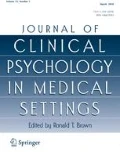Abstract
The data and discussion contained in this invited paper are based on the opening plenary by the first author whose paper titled “The Status of Ph.D.s in US Medical Schools” was presented at the 3rd national conference of the Association of Psychologists in Academic Health Centers, Minneapolis, MN, May 2007. The significant growth of the number of Ph.D.s in clinical departments is described, as is their distribution. The roles they play; the barriers they face in terms of leadership opportunities, promotion and tenure; and the concerns they voice that are specific to this population are also discussed. Salary differentials between Ph.D.s on main and medical school campuses are provided. Recommendations for future investigation of disparate treatment and for faculty development opportunities specifically aimed at this group are found at the conclusion of the paper.
Similar content being viewed by others
References
American Association of Medical Colleges. (2005). AAMC Faculty Policies Search Tool. Retrieved December 5, 2005 from https://services.aamc.org/dsportal/index.cfm?fuseaction=login.login&thread=jump.PRIVATESCHOOLPOLICY&appname=privatesite&frompermissionscheck=true (password required).
American Association of Medical Colleges. (2006). AAMC Faculty Roster (2006). Table 6: Distribution of U.S. medical school faculty by degree and department. Retrieved November 28, 2007 from http://www.aamc.org/data/facultyroster/usmsf06/06table6.xls.
American Association of Medical Colleges. (2006). Table 25. In Report on Medical School Faculty Salaries. American Association of Medical Colleges (2005/2006) Data Services, Washington, DC: Author.
American Association of Medical Colleges. (2007). Special report of full-time faculty counts by department, degree and tenure status as of December 31, 2006. Based on AAMC Faculty Roster data. Retrieved December 10, 2007 (report not publicly available).
American Psychological Association. (2006). Faculty Salary Survey. APA Research Office, Washington DC: Author.
Ahrens, E. H. (1992). The crisis in clinical research. New York: Oxford University Press.
Arias, I. M. (1989). Sounding board: Training basic scientists to bridge the gap between basic science and its application to human disease. New England Journal of Medicine, 321, 972–974.
Bland, C. J., Center, B. A., Finstad, D. A., Risbey, K. R., & Staples, J. (2006). The impact of appointment type on the productivity and commitment of full-time faculty in research and doctoral institutions. The Journal of Higher Education, 77, 89–123.
Brainard, J. (2004). What the NIH bought with double the money. Chronicle of Higher Education, 50(22), A17.
Bunton, S. A. P., & Mallon, W. T. E. (2006). The impact of centers and institutes on faculty life: Findings from a study of basic science and internal medicine faculty at research-intensive medical schools. Academic Medicine, 81, 734–743.
Bunton, S. A. P., & Mallon, W. T. E. (2007). The continued evolution of faculty appointment and tenure policies at U.S. medical schools. Academic Medicine, 82, 281–289.
Ellis, F. J. (1999). Jury out on the effect of post-tenure review on academic life. Academic Physician and Scientist, May-June, 1–5.
Eells, T. D. (2003). The role of the Ph.D. in medical school clinical departments. Workshop presented for the University of Louisville, School of Medicine, Louisville, KY, October 2003.
Eells, T. D. (2004). Faculty development and the special needs of Ph.D.s in clinical departments. Breakfast roundtable discussion for the AAMC Group on Faculty Affairs Development Conference, Tampa, FL, February 2004.
Fang, D. P., & Meyer, R. E. M. D. (2003). Ph.D. faculty in clinical departments of U.S. medical schools, 1981–1999: Their widening presence and roles in research. Academic Medicine, 78, 167–176.
Herman, S. S., & Singer, A. M. (1985). Basic scientists in clinical departments: A fast-growing component of medical school faculty. Washington, D.C.: Institute of Medicine.
Jones, R. F., & Gold, J. S. (1998). Faculty appointment and tenure policies in medical schools: 1997 status report. Academic Medicine, 73, 212–219.
Jones, R. F., & Gold, J. S. (2001). The present and future of appointment, tenure, and compensation policies for medical school faculty. Academic Medicine, 76, 993–1004.
Liaison Committee on Medical Education. (2007). Functions and structure of a medical school: Accreditation standards. Retrieved December 1, 2007 from http://www.lcme.org/pubs.htm.
Liu, M., & Mallon, W. T. (2004). Tenure in transition: Trends in basic science faculty appointment policies at U.S. medical schools. Academic Medicine, 79, 205–213.
Mandel, H. G., & The National Caucus of Basic Biomedical Science Chairs (1997). Downsizing of basic science departments in U.S. Medical School: Perceptions of their chairs. Academic Medicine, 72, 894–900.
National Institutes of Health. (2005). NIH Roadmap. Retrieved November 28, 2007 from http://www.nihroadmap.nih.gov/.
Schweitzer, L. (2007). The status of Ph.D.s in U.S. medical schools. Paper presented at the Association for Psychologists in Academic Health Centers, Minneapolis, MN, May 2007.
Schweitzer, L. P., & Eells, T. D. (2007). Post-tenure review at the University of Louisville School of Medicine: A faculty development and revitalization tool. Academic Medicine, 82, 713–717.
Acknowledgements
The authors would like to thank Dr. Barbara Feise, Chair of the Department of Psychology at Syracuse University, and Dr. Ed Lipson, Chair of the Department of Physics at Syracuse University, for providing disciplinary salary data. The authors would also like to thank Dr. Hershel Alexander and Mr. Jon Lang of the American Association of Medical Colleges for designing and executing the special analysis of department classification, degree type, and tenure status.
Author information
Authors and Affiliations
Corresponding author
Rights and permissions
About this article
Cite this article
Schweitzer, L., Eells, T.D. The Forgotten Faculty: Challenges for Ph.D.s in Clinical Medical School Departments. J Clin Psychol Med Settings 15, 7–11 (2008). https://doi.org/10.1007/s10880-008-9095-x
Received:
Accepted:
Published:
Issue Date:
DOI: https://doi.org/10.1007/s10880-008-9095-x



